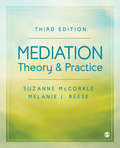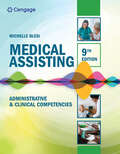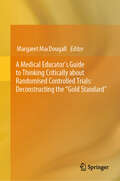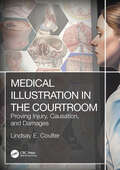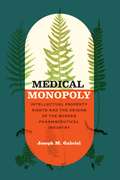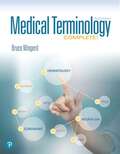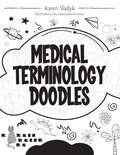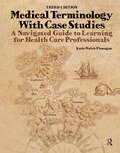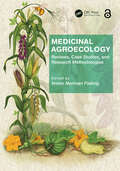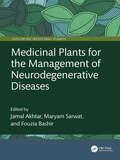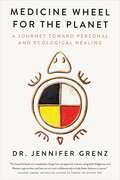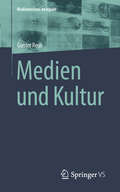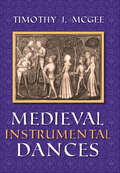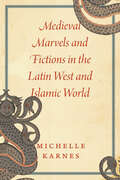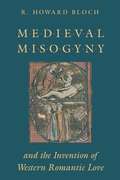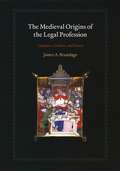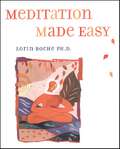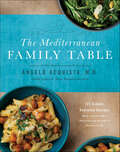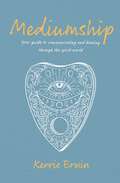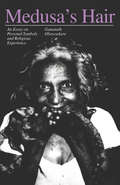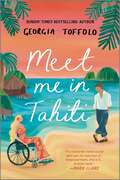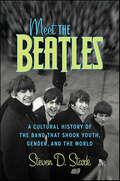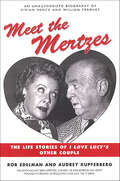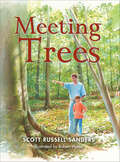- Table View
- List View
Mediation Theory and Practice
by Melanie J. Reese Suzanne McCorkleMediation Theory and Practice, Third Edition introduces students to the process of mediation by using practical examples that show students how to better manage conflicts and resolve disputes. Authors Suzanne McCorkle and Melanie J. Reese help students to understand the research and theory that underlie mediation, as well as provide students with the foundational skills a mediator must possess in any context, including issue identification, setting the agenda for negotiation, problem solving, settlement, and closure. New to the Third Edition: Expanded content on the role of evaluative mediation reflects the latest changes to the alternative dispute resolution field, helping students to distinguish between various approaches to mediation. Additional discussions around careers in conflict management familiarize students with employment opportunities for mediators, standards of professional conduct, and professional mediator competencies. New activities and case studies throughout each chapter assist students in developing their mediation competency.
Mediation Theory and Practice
by Melanie J. Reese Suzanne McCorkleMediation Theory and Practice, Third Edition introduces students to the process of mediation by using practical examples that show students how to better manage conflicts and resolve disputes. Authors Suzanne McCorkle and Melanie J. Reese help students to understand the research and theory that underlie mediation, as well as provide students with the foundational skills a mediator must possess in any context, including issue identification, setting the agenda for negotiation, problem solving, settlement, and closure. New to the Third Edition: Expanded content on the role of evaluative mediation reflects the latest changes to the alternative dispute resolution field, helping students to distinguish between various approaches to mediation. Additional discussions around careers in conflict management familiarize students with employment opportunities for mediators, standards of professional conduct, and professional mediator competencies. New activities and case studies throughout each chapter assist students in developing their mediation competency.
Medical Assisting: Administrative and Clinical Competencies
by Virginia Ferrari Michelle BlesiStrengthen your knowledge base as well as the critical skills and behaviors needed to become a successful entry-level medical assistant with Blesi's MEDICAL ASSISTING: ADMINISTRATIVE AND CLINICAL COMPETENCIES, 9E. Clear and easy to understand, this streamlined edition now includes a complete, updated section on the structure and function of body systems with current medical terminology presented in context. Updates highlight the latest information in nutrition, the Affordable Care Act (ACA), ICD-10 and electronic health records. Expanded content focuses on increasing your personal effectiveness as you study professionalism, teamwork and time management. New chapters also discuss geriatrics and mental health -- topics of growing importance. You examine the latest procedures as you increase your general, administrative and clinical competencies. MindTap digital resources help you further develop a competitive advantage as you pursue a career in medical assisting today.
A Medical Educator's Guide to Thinking Critically about Randomised Controlled Trials: Deconstructing the "Gold Standard"
by Margaret MacDougallDrawing on the statistical and philosophical expertise of its authors, this book is designed to improve understanding and use of randomised controlled trials (RCTs) among health professionals. It is intended for use primarily by medical educators involved in teaching statistics and evidence-based medicine (EBM) to medical students, junior doctors and other health professionals. However, each of the chapters serves a wider range of interests, including the practical needs of physicians in interpreting research evidence to support clinical decision making and the teaching needs of philosophers of medicine who want to more fully appreciate how RCTs work in practice and provide engaging examples for their students. Rather than compete with the proliferating methodological literature on RCT designs, this book focuses on cultivating a healthy skepticism among developing health professionals to support critical appraisal of their own and published work on RCTs at a fundamental level, including through a more informed understanding of the place of subgroup analyses in sound statistical inference. Management of the positive predictive value in the statistical analysis of RCT findings is included as an important topic for contemporary medical curricula. In comparing RCTs with non-randomised studies, a search for empirical evidence for the superiority of RCTs is initiated, pointing to the need for further work to confirm what form this evidence should take.Medical educators will find a wealth of reasons to encourage their students to think more critically about how the RCT operates in practice as a gold standard.
Medical Illustration in the Courtroom: Proving Injury, Causation, and Damages
by Lindsay E. CoulterMedical Illustration in the Courtroom: Proving Injury, Causation, and Damages educates the reader on how to communicate science visually—in personal injury, medical malpractice, criminal, and forensic cases—by creating art that utilizes medical records, radiographs, and computer software. Medical illustration bridges the gap between complex technical, medical, and scientific concepts to clearly illustrate, and explain visually, a medical condition, negligence, or the causation of an injury or death to the lay person. Medical artists are frequently challenged with illustrating injuries and medical conditions that can’t be seen by the naked eye. And while using medical photography and imaging for illustrative purposes can be helpful, to an untrained eye it can often be unclear or confusing. This is where the medical illustrator enters the equation. There are often patients who have recovered from an injury or infection that appear in good health. However, should an unforeseen injury or fatality happen, medical illustrators can reveal to people what’s actually going on inside the person, an invaluable asset to attorneys in the courtroom—especially for personal injury and medical malpractice cases. While many attorneys utilize medical artists, nonvisual people don’t always recognize the value of demonstrative aids until they see them first-hand.When attorneys and their clients enlist the aid of medical artists, it quickly becomes apparent that properly conceived and executed artwork is invaluable to illustrating the facts—and medical impacts—of any number of scenarios: homicides by shooting, stabbings, vehicular accidents, in addition to medical malpractice and personal injuries resulting from surgery or possible negligence.Presenting a myriad of services and computer technologies that can be utilized, Medical Illustration in the Courtroom provides demonstrative aids used in cases to illustrate personal injury and medical malpractice, employing "tricks of the trade" to create an accurate effective image. Such images are educational to attorneys, insurance adjusters, judges, and juries to help create a visual storyline, the goal being to help combine art and science to provide a clear illustration of events to help in adjudicate legal and forensic cases.
Medical Monopoly: Intellectual Property Rights and the Origins of the Modern Pharmaceutical Industry (Synthesis Ser.)
by Joseph M. GabrielDuring most of the nineteenth century, physicians and pharmacists alike considered medical patenting and the use of trademarks by drug manufacturers unethical forms of monopoly; physicians who prescribed patented drugs could be, and were, ostracized from the medical community. In the decades following the Civil War, however, complex changes in patent and trademark law intersected with the changing sensibilities of both physicians and pharmacists to make intellectual property rights in drug manufacturing scientifically and ethically legitimate. By World War I, patented and trademarked drugs had become essential to the practice of good medicine, aiding in the rise of the American pharmaceutical industry and forever altering the course of medicine. Drawing on a wealth of previously unused archival material, Medical Monopoly combines legal, medical, and business history to offer a sweeping new interpretation of the origins of the complex and often troubling relationship between the pharmaceutical industry and medical practice today. Joseph M. Gabriel provides the first detailed history of patent and trademark law as it relates to the nineteenth-century pharmaceutical industry as well as a unique interpretation of medical ethics, therapeutic reform, and the efforts to regulate the market in pharmaceuticals before World War I. His book will be of interest not only to historians of medicine and science and intellectual property scholars but also to anyone following contemporary debates about the pharmaceutical industry, the patenting of scientific discoveries, and the role of advertising in the marketplace.
Medical Terminology Complete!
by Bruce WingerdMedical Terminology Complete! takes a programmed approach to presenting the most current language of healthcare. Organized by body system, the text conveys the medical terms used in medical offices, hospitals and clinics, together with essential A&P information. You'll get step-by-step guidance in building medical terms. Word Part Reminders show you how word parts combine to form a term, while Word Part Breakdowns identify word parts. Some exercises offer word-building practice, while others use medical reports to show how medical terms are used in practice. The 4th Edition improves clinical training for students poised to a launch a healthcare career. New types of chapter-ending exercises, such as Define the Combining Form and Complete the Labels exercises, round out a comprehensive series of practice opportunities.
Medical Terminology Doodles
by Karen SladykToday's students have expressed a strong preference for multiple modes of information delivery, including visual, auditory and kinesthetic. Medical Terminology Doodles by Dr. Karen Sladyk is a unique book based on evidence that suggests that a multi-sensory approach that includes doodling can promote better knowledge retention than traditional methods in learning medical terminology.Medical Terminology Doodles offers 266 of the most common medical terms to explore and learn through doodling. By drawing or doodling related images, students will create permanent connections between the brain and the terms, as well as their root words, prefixes, and suffixes. Study hints, spelling hints, and sample illustrations are offered for each of the words, but students are also encouraged to personalize their learning by assigning meaning to the terms and creating their own “art.” Using visual cues to remember information will encourage students to review the material at hand and will also help them understand the way that terms connect to larger medical concepts. Medical Terminology Doodles is a must-have for students looking for a unique manner in which to engage with complicated scientific material. On the road to becoming a successful practitioner in the health professions, you can never underestimate the power of a doodle!
Medical Terminology with Case Studies: A Navigated Guide to Learning for Health Care Professionals
by Katie Walsh FlanaganMedical Terminology With Case Studies: A Navigated Guide to Learning for Health Care Professionals, Third Edition, is a fun, engaging, and easy-to-read resource on medical terminology for allied health students in athletic training, occupational therapy, physical therapy, and more.Featuring such memorable characters as Skully, the pirate skeleton, and Tango, his trusty parrot, Medical Terminology With Case Studies contains colorful illustrations throughout the text along with tear-out worksheets for students at the end of each chapter. The book is appropriate for students in both college and high school settings.The textbook is divided into three sections, each one covering key concepts and ideas related to medical terminology: Section I: A general overview of medical terminology, delving into its uses, purposes, and career-specific applications across specialties Section II: An in-depth examination of the specific body systems (musculoskeletal, cardiovascular, respiratory, neurological, gastrointestinal, integumentary, endocrine, urinary, reproductive, and sensory) and the associated prefixes, suffixes, and combining forms that go along with them Section III: Appendices, including medical abbreviations, ICD/CPT medical coding, and pharmacology terms Updated features in the Third Edition include: New terms throughout Updated graphics throughout New case studies New chapter on health professions Updated chapter bibliographies Included with the text are online supplemental materials for faculty use in the classroom.Combining bright, colorful characters with easy-to-read resources, Medical Terminology With Case Studies: A Navigated Guide toLearning for Health Care Professionals, Third Edition, is an invaluable terminology guide for allied health students.
Medicinal Agroecology: Reviews, Case Studies and Research Methodologies
by Immo Norman FiebrigMedicinal Agroecology: Reviews, Case Studies, and Research Methodologies presents information on applications of ‘green therapies’ in restoration towards global sustainability. These practices connect the world of medicinal plants with ecologic farming practice, creating a compassionate socio-political worldview and heartfelt scientific research towards food sovereignty and a healthier future on planet Earth. The book communicates benefits of using plant-based solutions to manage the challenges of unsustainable practices in human healthcare, veterinary medicine, agriculture, forestry, and water management. The contributions introduce advances around plants and their active components to potentially treat disease, regulate dysfunction, and balance ecosystems. These practices are explored in further depth through three sections: POLICIES AND FRAMEWORKS, INSIGHTS AND OVERVIEWS, and CASE STUDIES AND RESEARCH METHODS. Edited by Immo Norman Fiebrig, Medicinal Agroecology: Reviews, Case Studies, and Research Methodologies appeals to those in various disciplines including agriculture and agroecology, healthcare, environmental sciences, and veterinary medicine.Chapters 3 and 9 of this book are freely available as a downloadable Open Access PDF at http://www.taylorfrancis.com under a Creative Commons [Attribution-Non Commercial-No Derivatives (CC-BY-NC-ND)] 4.0 license.
Medicinal Plants for the Management of Neurodegenerative Diseases (Exploring Medicinal Plants)
by Maryam Sarwat Jamal Akhtar Fouzia BashirAgeing is the main reason for most neurodegenerative diseases, including Alzheimer’s disease (AD) and Parkinson’s disease (PD). About 10% of individuals aged ≥65 years develop AD, which continuously increases with growing age. Medicinal plants have been used for age-related neurodegenerative disorders for a long time. These plants are rich in terms of various phytochemical constituents such as flavonoids, sterols, alkaloids, saponins, and terpenoids. Different scientific studies have been carried out on these medicinal herbs, e.g., anti-inflammatory, antioxidant, and neuro-regenerative activities that may be used in the treatment of AD and other age-related diseases. These medicinal plants, e.g., Curcuma longa, Bacopa monniera, Glycyrrhiza glabra, Commiphora whighitti, and Acorus calamus L., have anti-inflammatory properties that may decrease swelling of the brain tissue in AD.Despite this, there is currently no book available in the market that provides full information on the phytochemical and medicinal uses of the medicinal plants exclusively used for the management of neurodegenerative diseases in the elderly. This book aims to provide some important and evidence-based information on the plants used for neurodegenerative diseases in the elderly, especially AD and PD, in a planned manner so the academicians, researchers, and students working in the fields of medicinal plants, plant science, chemistry, biotechnology, pharmacognosy, pharmaceuticals, biochemistry, and many other interdisciplinary subjects may benefit. This book will also be useful in identifying a few medicinal plants and their prospects for the synthesis or preparation of new drugs for neurodegenerative diseases.Features: An overview of the medicinal plants that can be helpful for neurodegenerative disorders Recent research results and some pointers for the management of neurodegenerative diseases This book serve as comprehensive information about the description, phytochemistry, actions, and medicinal use of plants that are used in neurodegenerative diseases. In addition, this book will also ease the understanding and interaction of medicinal plants used in neurodegenerative diseases.
Medicine Wheel for the Planet: A Journey Toward Personal and Ecological Healing
by Jennifer GrenzA personal journey of bringing together Western science and Indigenous ecology to transform our understanding of the human role in healing our planetI used to be an ecologist. . . . Now, I am a community gatherer, working to help bring healing beyond just the land. I am a story-listener. I am a storyteller. I am a shaper of ecosystems. I work on bringing communities together, in circle, to listen to each other. A farm kid at heart, and a Nlaka&’pamux woman of mixed ancestry, Dr. Jennifer Grenz always felt a deep connection to the land. However, after nearly two decades of working as a restoration ecologist in the Pacific Northwest, she became frustrated that despite the best efforts of her colleagues and numerous volunteers, they weren&’t making the meaningful change needed for plant, animal, and human communities to adapt to a warming climate. Restoration ecology is grounded in an idea that we must return the natural world to an untouched, pristine state, placing humans in a godlike role—a notion at odds with Indigenous histories of purposeful, reciprocal interaction with the environment. This disconnect sent Dr. Grenz on a personal journey of joining her head (Western science) and her heart (Indigenous worldview) to find a truer path toward ecological healing. In Medicine Wheel for the Planet, building on sacred stories, field observations, and her own journey, Dr. Grenz invites readers to share in the teachings of the four directions of the medicine wheel: the North, which draws upon the knowledge and wisdom of elders; the East, where we let go of colonial narratives and see with fresh eyes; the South, where we apply new-old worldviews to envision a way forward; and the West, where a relational approach to land reconciliation is realized. Eloquent, inspiring, and disruptive, Medicine Wheel for the Planet circles around an argument that we need more than a singular worldview to protect the planet and make the significant changes we are running out of time for.
Medien und Kultur (Medienwissen kompakt)
by Gunter ReusMedien bestimmen unseren Alltag in jeder Lebenslage. Viele Menschen empfinden ihre Macht aber als gefährlich für die gesellschaftliche Kultur. Gunter Reus zeigt dagegen, wie sehr ein Gemeinwesen auf der kulturellen Leistung der Massenmedien aufbaut. Der Autor bedient sich dabei eines weiten Kulturbegriffs und zeichnet nach, wie sie Errungenschaften der Menschheit historisch ausgeformt haben. Ohne Medien gäbe es keine einheitliche Sprache und keinen Austausch von Information und Wissen, wie wir ihn kennen. Es gäbe keine Ausbalancierung sozialer Interessen, keine Kontrolle von Macht, keine Orientierung auf das Gemeinwohl, kein Kunstleben. Auch im Internetzeitalter bleiben Massenmedien, bei aller notwendigen Kritik an ihren Schattenseiten, unverzichtbar als Kulturträger. Sie sorgen für die Transparenz politischen Handelns ebenso wie für die (potentielle) Teilhabe aller am Kunstgeschehen. Damit prägen sie die Kultur der Demokratie wie auch die Kultur in der Demokratie entscheidend mit.
Medieval Instrumental Dances
by Timothy J. McGeeIn Europe the tradition of secular dance has continued unbroken until the present. In the late Middle Ages it was an important and frequent event—for the nobility a gracious way to entertain guests, for the peasantry a welcome relaxation from the toils of the day. Now back in print, this collection presents compositions that are known or suspected to be instrumental dances from before ca. 1420. The 47 pieces vary in length and style and come from French, Italian, English, and Czech sources. Timothy McGee relates medieval dances to the descriptions found in literary, theoretical, and archival sources and to the depictions in the iconography of the Middle Ages. In a section on instrumental performance practices, he provides information about ornamenting the dances and improvising in a historically appropriate style. This comprehensive edition brings together in one volume a repertory that has been scattered over many years and countries.
Medieval Marvels and Fictions in the Latin West and Islamic World
by Michelle KarnesA cross-cultural study of magical phenomena in the Middle Ages. Marvels like enchanted rings and sorcerers’ stones were topics of fascination in the Middle Ages, not only in romance and travel literature but also in the period’s philosophical writing. Rather than constructions of belief accepted only by simple-minded people, Michelle Karnes shows that these spectacular wonders were near impossibilities that demanded scrutiny and investigation. This is the first book to analyze a diverse set of writings on such wonders, comparing texts from the Latin West—including those written in English, French, Italian, and Castilian Spanish —with those written in Arabic as it works toward a unifying theory of marvels across different disciplines and cultures. Karnes tells a story about the parallels between Arabic and Latin thought, reminding us that experiences of the strange and the unfamiliar travel across a range of genres, spanning geographical and conceptual space and offering an ideal vantage point from which to understand intercultural exchange. Karnes traverses this diverse archive, showing how imagination imbues marvels with their character and power, making them at once enigmatic, creative, and resonant. Skirting the distinction between the real and unreal, these marvels challenge readers to discover the highest capabilities of both nature and the human intellect. Karnes offers a rare comparative perspective and a new methodology to study a topic long recognized as central to medieval culture.
Medieval Misogyny and the Invention of Western Romantic Love
by R. Howard BlochUntil now the advent of Western romantic love has been seen as a liberation from—or antidote to—ten centuries of misogyny. In this major contribution to gender studies, R. Howard Bloch demonstrates how similar the ubiquitous antifeminism of medieval times and the romantic idealization of woman actually are. Through analyses of a broad range of patristic and medieval texts, Bloch explores the Christian construction of gender in which the flesh is feminized, the feminine is aestheticized, and aesthetics are condemned in theological terms. Tracing the underlying theme of virginity from the Church Fathers to the courtly poets, Bloch establishes the continuity between early Christian antifeminism and the idealization of woman that emerged in the twelfth and thirteenth centuries. In conclusion he explains the likely social, economic, and legal causes for the seeming inversion of the terms of misogyny into those of an idealizing tradition of love that exists alongside its earlier avatar until the current era. This startling study will be of great value to students of medieval literature as well as to historians of culture and gender.
The Medieval Origins of the Legal Profession: Canonists, Civilians, and Courts
by James A. BrundageIn the aftermath of sixth-century barbarian invasions, the legal profession that had grown and flourished during the Roman Empire vanished. Nonetheless, professional lawyers suddenly reappeared in Western Europe seven hundred years later during the 1230s when church councils and public authorities began to impose a body of ethical obligations on those who practiced law. James Brundage’s The Medieval Origins of the Legal Profession traces the history of legal practice from its genesis in ancient Rome to its rebirth in the early Middle Ages and eventual resurgence in the courts of the medieval church. By the end of the eleventh century, Brundage argues, renewed interest in Roman law combined with the rise of canon law of the Western church to trigger a series of consolidations in the profession. New legal procedures emerged, and formal training for proctors and advocates became necessary in order to practice law in the reorganized church courts. Brundage demonstrates that many features that characterize legal advocacy today were already in place by 1250, as lawyers trained in Roman and canon law became professionals in every sense of the term. A sweeping examination of the centuries-long power struggle between local courts and the Christian church, secular rule and religious edict, The Medieval Origins of the Legal Profession will be a resource for the professional and the student alike.
Meditation Made Easy
by Lorin RocheYou′ve probably heard about the benefits of meditation: Sharper thinking, reduced stress, improved concentration, lower blood pressure, even increased sexual pleasure , all of these positive effects have been confirmed by science. In this uniquely accessible guide, Lorin Roche shows that meditation is that easy , and pleasurable. Roche answers questions and debunks meditation myths, and gives three easy-to-follow techniques for getting started 塴he Do Nothing Technique," "Salute Each of the Senses," and "Feeling at Home Exercise". He and shows you how to integrate "mini meditations" into spare moments of the day, from savouring morning coffee to taking advantage of the five minutes before a meeting. He explains how to overcome meditation obstacles, customise meditation to your own needs, and use your breath, voice, and attention as meditation aids. And he shows how meditation will give you the power to explore your inner passions , and enrich your sense of self.
The Mediterranean Family Table: 125 Simple, Everyday Recipes Made with the Most Delicious and Healthiest Food on Earth
by Angelo Acquista Laurie Ann VandermolenTutti a tavola—All to the table with this bounty of Mediterranean recipes to try, savor, and gather aroundTo help his patients improve their health, Dr. Angelo Acquista began “prescribing” them recipes for nutritious and flavorful home-cooked meals prepared with ingredients key to the Mediterranean diet. The Mediterranean Family Table combines his medical experience and Sicilian roots to outline the guiding principles of the Mediterranean diet and takes it one step further with a collection of easy, wholesome, and delicious recipes the entire family will love.From purees made with fresh vegetables that will tempt the taste buds of bambini—and can serve as easy sides for the rest of the family—to recipes tailored to meet the special nutritional needs of children and seniors (highlighted by icons for easy reference), this well-curated collection of recipes will allow you to:• Reinvent classic recipes by replacing mayonnaise and butter with heart-healthy olive oil in dishes like Mediterranean Potato Salad and Olive Oil Mashed Potatoes• Discover good-for-you Mediterranean greens in kid-approved recipes like Orecchiette with Bread Crumbs and Broccoli Rabe, and Swiss Chard and Cannellini Beans alla Alessandra• Create your own “Sunday Supper” family tradition with recipes like Quick and Easy Tomato Sauce and Mama’s Meatballs with PastaThe Mediterranean Family Table contains a wealth of helpful information, including how to make healthier eating choices; instill good habits in kids that will last a lifetime; and buy, store, and cook ingredients fundamental to the Mediterranean diet. Anecdotes from Acquista’s family history are woven throughout, as well as stories of growing up near the Mediterranean Sea, and the techniques he uses to incorporate what he learned from his Sicilian upbringing into his busy, landlocked, modern family life. Buon appetito!
Mediumship: Your guide to communicating and healing through the spirit world
by KERRIE ERWINThe ultimate book of authentic lunar ceremonies, spells, mythos and science, Enchanted Moon will transform and inspire you. The alchemy of lunar science will show you how moon cycles work for magic, balance, health and self-realisation and about how both ancient and modern rituals will help you get the most power from those cycles. Also included are authentic meditations or spells for every one of the 28 phases of the moon, crystal suggestions for each moon phase, gardening by the moon guidelines and a handy 15-year chart of full, dark and new moons for easy reference. Let the beliefs of the goddesses, gods and sacred animals of the moon guide you towards a better life. Whether you are a beginner or an advanced practitioner, this moonlit book is for you.
Medusa's Hair: An Essay on Personal Symbols and Religious Experience
by Gananath ObeyesekereThe great pilgrimage center of southeastern Sri Lanka, Kataragama, has become in recent years the spiritual home of a new class of Hindu-Buddhist religious devotees. These ecstatic priests and priestesses invariably display long locks of matted hair, and they express their devotion to the gods through fire walking, tongue-piercing, hanging on hooks, and trance-induced prophesying. The increasing popularity of these ecstatics poses a challenge not only to orthodox Sinhala Buddhism (the official religion of Sri Lanka) but also, as Gananath Obeyesekere shows, to the traditional anthropological and psychoanalytic theories of symbolism. Focusing initially on one symbol, matted hair, Obeyesekere demonstrates that the conventional distinction between personal and cultural symbols is inadequate and naive. His detailed case studies of ecstatics show that there is always a reciprocity between the personal-psychological dimension of the symbol and its public, culturally sanctioned role. Medusa's Hair thus makes an important theoretical contribution both to the anthropology of individual experience and to the psychoanalytic understanding of culture. In its analyses of the symbolism of guilt, the adaptational and integrative significance of belief in spirits, and a host of related issues concerning possession states and religiosity, this book marks a provocative advance in psychological anthropology.
Meet Me in Tahiti
by Georgia Toffolo&“I fell in love with Finn and Zoe. I didn&’t want it to end. Each book in this series has gotten better and better.&” —Sherryl Woods, New York Times bestselling authorZoe Tayler has spent her life doing battle: first fighting her parents for independence and then, after a car accident at eighteen, adjusting to the fact she would not walk again. She remained strong until the day Finn Doherty, the one person she thought she could trust, broke her heart. Now a successful travel writer, Zoe is excited to be reviewing a new luxury hotel for her blog in the beautiful South Pacific—until she meets its owner.Finn was never good enough for Zoe. He knew it. Zoe&’s family knew it. The village of Hawkes Cove made sure he knew it. And then he proved everyone right when he let her down in the worst way possible. Becoming a successful businessman has convinced Finn his past is behind him—until a journalist turns up to review his new resort.Meeting again stirs up all the old feelings, and all the painful memories that pulled them apart, too. As Finn shows Zoe the exotic wonders of the islands, both face the fact their shared past might just be the beginning of a future. But only if Zoe can win the biggest battle of her life—facing up to her heart&’s desire.Read about Zoe's friends in the rest of the Meet Me series by Georgia Toffolo: Meet Me in London Meet Me at the Wedding Meet Me in Tahiti
Meet the Beatles: A Cultural History of the Band that Shook Youth, Gender, and the World
by Steven D. StarkRob Sheffield, the Rolling Stone columnist and bestselling author of Love Is a Mix Tape, offers an entertaining, unconventional look at the most popular band in history, the Beatles, exploring what they mean today and why they still matter so intensely to a generation that has never known a world without them.Meet the Beatles is not another biography of the Beatles, or a song-by-song analysis of the best of John and Paul. It isn’t another exposé about how they broke up. It isn’t a history of their gigs or their gear. It is a collection of essays telling the story of what this ubiquitous band means to a generation who grew up with the Beatles music on their parents’ stereos and their faces on T-shirts. What do the Beatles mean today? Why are they more famous and beloved now than ever? And why do they still matter so much to us, nearly fifty years after they broke up?As he did in his previous books, Love is a Mix Tape, Talking to Girls About Duran Duran, and Turn Around Bright Eyes, Sheffield focuses on the emotional connections we make to music. This time, he focuses on the biggest pop culture phenomenon of all time—The Beatles. In his singular voice, he explores what the Beatles mean today, to fans who have learned to love them on their own terms and not just for the sake of nostalgia. Meet the Beatles tells the story of how four lads from Liverpool became the world’s biggest pop group, then broke up—but then somehow just kept getting bigger. At this point, their music doesn’t belong to the past—it belongs to right now. This book is a celebration of that music, showing why the Beatles remain the world’s favorite thing—and how they invented the future we’re all living in today.
Meet the Mertzes: The Life Stories of I Love Lucy's Other Couple
by Rob Edelman Audrey KupferbergMeet the Mertzes is an expansive dual biography chronicling the lives of two of America's most popular situation-comedy actors, William Frawley and Vivian Vance, who portrayed Fred and Ethel Mertz on I Love Lucy. This meticulously researched book contains interviews with Frawley's and Vance's colleagues, friends, and relatives, and explores their personal and professional lives before, during, and after I Love Lucy. With a complete filmography and videography of each, Meet the Mertzes finally sets the record straight on the lives and legacies of these compelling stars who detested one another.You'll learn about:-Vance's successful Broadway career prior to I Love Lucy-Frawley's vaudevillian roots and his passion for baseball-Vance's nervous breakdown after the collapse of her first marriage-Frawley's drinking and carousing-Lucille Ball's caustic relationship with both of her costars-Vance's hatred of being known to the world as Ethel Mertz
Meeting Trees
by Scott Russell SandersYoung Scott and his father have a personal way of learning the trees and remembering their names. It's a game they like to play, one you'll want to play too!Learn the name of the swallowtail butterfly who loves to sit on the dogwood branch, see the majestic beauty of the black-and-yellow Argiope spider, or see what makes the beech tree so special (its bark is smooth and gray just like the skin of a hippo).Featuring beautiful paintings by nature artist Robert Hynes and the exquisite language of renowned author Scott Russell Sanders, Meeting Trees captures the delicate details of bark, branches, and leaves while enchanting readers with the beauty of the natural world.
